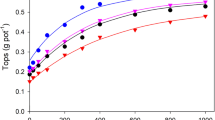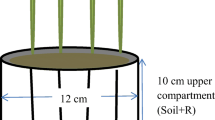Abstract
The relative effectiveness (RE) of each one of three different sources of P—P in solution (Psol), triple superphosphate (TSP) and phosphate rock (PR)—for reflecting the availability of P in a P-deficient soil were assessed by measuring in Lotus tenuis variables associated with growth, organ morphology, and plant tissue P-content together with the amounts of P extracts from soil by two of the currently used soil-P tests—Bray I and Olsen. A hyperbolic equation was used to fit the response curves of each one of those plant variables to added-P. The ratio between the shapes of paired response curves of any P-sources was used to compute the RE and substitution rate (K) of one source relative to the other. More P was needed from TSP and PR compared to Psol-100% soluble P-source. On the average P applications as TSP relative to Psol and PR relative to TSP were only 68 and 63% effective respectively for plant growth. Plant roots were more sensitive than soil-P tests to detect shifts in P-availability from different P-sources. Because soil tests are commonly used to estimate the current P status in soil in order to calculate the optimum application levels of fertilizer P for a crop or pasture, these results would have practical agronomical consequences if reproduced in other cultivated species because they show that the response curve of a plant species as a function of added P and soil test might differ among fertilizer types, measured plant variables, and the test used to measure P availability in the soil.





Similar content being viewed by others
References
Barrow NJ (1980) Evaluation and utilization of residual phosphorus in soils. In: Khasawneh FE, Sample EC, Kamprath EJ (eds) The role of phosphorus in agriculture, Chap. 13. American Society of Agronomy, Madison, pp 339–359
Barrow NJ (1985) Reaction of anions and cations with variable-charge soils. Adv Agron 38:183–230. doi:10.1016/S0065-2113(08)60676-8
Barrow NJ, Bolland MDA (1990) A comparison of methods for measuring the effect of level of application on the relative effectiveness of two fertilizers. Fertil Resolut 26:1–10. doi:10.1007/BF01048739
Barrow NJ, Mendoza RE (1990) Equations for describing sigmoid yield responses and their application to some phosphate responses by lupins and by subterranean clover. Fertil Resolut 22:81–188. doi:10.1007/BF01120393
Bolan NS, Robson AD, Barow NJ (1983) Plant and soil factors including mycorrhizal infection causing sigmiodal response of plant to applied phosphorus. Plant Soil 73:187–201. doi:10.1007/BF02197715
Bolland MDA, Barrow NJ (1991) The effect of level of application on the residual value of superphosphate on a sandy soil in south-western Australia. Fertil Resolut 29:163–172. doi:10.1007/BF01048956
Bolland MDA, Gilkes RJ (1992) Evaluation of the Bray 1, calcium acetate lactate (CAL), Truog and Colwell soil tests as predictors of triticale grain production on soil fertilized with superphosphate and rock phosphate. Fertil Resolut 31:372–636
Bray RH, Kurtz LT (1945) Determination of total organic and available forms of phosphorus in soils. Soil Sci 59:39–45. doi:10.1097/00010694-194501000-00006
Campbell NA, Keay J (1970) Flexible technique in describing mathematically a range of response curves of pasture species. In: Proceedings of XII International Grassland Congress. pp 332–334
Chien SH (2004) Soil testing for phosphate rock application. In: Zapata F, Roy RN (eds) Use of phosphate rocks for sustainable agriculture, Chap. 6. FAO, Rome, pp 59–67 (180 pp)
Chien SH, Black CA (1976) Free energy of formation of carbonate apatites in some phosphate rocks. Soil Sci Soc Am J 40:234–239
Chien SH, Sale PWE, Friesen DK (1990) A discussion of the methods for comparing the relative effectiveness of phosphate fertilizers varying in solubility. Fertil Resolut 28:11–24
Covacevich F, Marino MA, Echeverria HE (2006) The phosphorus source determines the arbuscular mycorhizal potential and the native mycorrhizal colonization of tall fescue and wheatgrass. Eur J Soil Biol 42:127–138. doi:10.1016/j.ejsobi.2005.12.002
Escudero V, Mendoza RE (2005) Seasonal variation of arbuscular mycorrhizal fungi in temperate grasslands along a wide hydrologic gradient. Mycorrhiza 15:291–299. doi:10.1007/s00572-004-0332-3
Garcia IV, Mendoza RE (2008) Relationships among soil properties, plant nutrition and arbuscular mycorrhizal fungi-plant symbioses in a temperate grassland along hydrologic, saline and sodic gradients. FEMS Microbiol Ecol 63:359–371. doi:10.1111/j.1574-6941.2008.00441.x
Ginzo HD, Collantes MB, Caso OH (1982) Fertilization of a native grassland in the Salado River Basin, Argentina: herbage dry matter, botanical composition, and mineral content. J Range Manag 35:35–39. doi:10.2307/3898513
Hidalgo L, Cauhépé MA (1991) Effects of seasonal rest in a above-ground biomass for native grassland of the flooding Pampa, Argentina. J Range Manag 44:471–475. doi:10.2307/4002747
Jackson ML (1958) Soil chemical analysis. In: Black CA, Evans DD, White JR, Ensminger GE, Clarck FE (eds) Method of soil analysis, Part 2. Chemical and microbiological properties. Prentice Hall, Inc., Englewood Cliffs, p 801
Kanabo I, Gilkes RJ (1988a) The effect of particle size on North Caroline phosphate rock on its dissolution in soil and on the levels of bicarbonate-soluble phosphorus. Fertil Resolut 15:137–145. doi:10.1007/BF01050675
Kanabo I, Gilkes RJ (1988b) A comparison of mixed and band applications on the dissolution of North Caroline phosphate rock and on bicarbonate-soluble soil phosphorus. Fertil Resolut 15:3–12. doi:10.1007/BF01049183
Khasawneh FE, Doll EC (1978) The use of phosphate rock for direct application to soil. Adv Agron 30:159–204. doi:10.1016/S0065-2113(08)60706-3
Kumar V, Gilkes RJ, Bolland MDA (1992) The residual value of rock phosphate and superphosphate from field sites assessed by glasshouse bioassay using three plant species with different external P requirements. Fertil Resolut 32:195–207. doi:10.1007/BF01048782
Mendoza RE (2001) Phosphorus nutrition and mycorrhizal growth response of broadleaf and narrowleaf birdsfoot trefoils. J Plant Nutr 24(1):1–12. doi:10.1081/PLN-100000321
Mendoza RE, Barrow NJ (1987) Ability of three soil tests to reflect the factors which determine the availability of soil phosphate. Soil Sci 144:319–328. doi:10.1097/00010694-198711000-00002
Miñón DP, Sevilla H, Montes L, Fernández ON (1990) Lotus tenuis: leguminosa forrajera para la Pampa Deprimida. Boletín Técnico N° 98. EEA Balcarce, INTA, Argentina
Nelder JA, Mead R (1965) A simplex method for function minimization. Comput J 7:308–313
Olsen SR, Cole CV, Watanabe FS, Dean LA (1954) Estimation of available phosphorus in soils by extraction with sodium bicarbonate. US Dept Agric Circ No. 939
Ozanne PG, Keay J, Biddiscombe EF (1969) The comparative applied phosphate requirements of eight annual pasture species. Aust J Agric Res 20:809–818. doi:10.1071/AR9690809
Phillips JM, Hayman DS (1970) Improved procedure for clearing roots and staining parasitic and vesicular-arbuscular mycorrhizal fungi for rapid assessment of infection. Trans Br Mycol Soc 55:158–161
Rajan SSS, Watkinson JH, Sinclair AG (1996) Phosphate rocks for direct application to soil. Adv Agron 57:77–159. doi:10.1016/S0065-2113(08)60923-2
Truong B (2004) Evaluation of phosphate rock for direct application. In: Zapata F, Roy RN (eds) Use of phosphate rocks for sustainable agriculture, Chap. 4. FAO, Rome, pp 27–42 (180 pp)
Zapata F, Roy RN (2007) Utilización de las rocas fosfóricas para una agricultura sostenible. Boletín FAO No 13, Roma, p 156
Acknowledgments
The authors would like to thank Dr. H. D. Ginzo for checking the English writing and Ing. Agr. Guillermo Publiese for providing the phosphate fertilizers used.
Author information
Authors and Affiliations
Corresponding author
Rights and permissions
About this article
Cite this article
Mendoza, R., del Carmen Lamas, M. & García, I. How do soil P tests, plant yield and P acquisition by Lotus tenuis plants reflect the availability of added P from different phosphate sources. Nutr Cycl Agroecosyst 85, 17–29 (2009). https://doi.org/10.1007/s10705-008-9245-4
Received:
Accepted:
Published:
Issue Date:
DOI: https://doi.org/10.1007/s10705-008-9245-4




